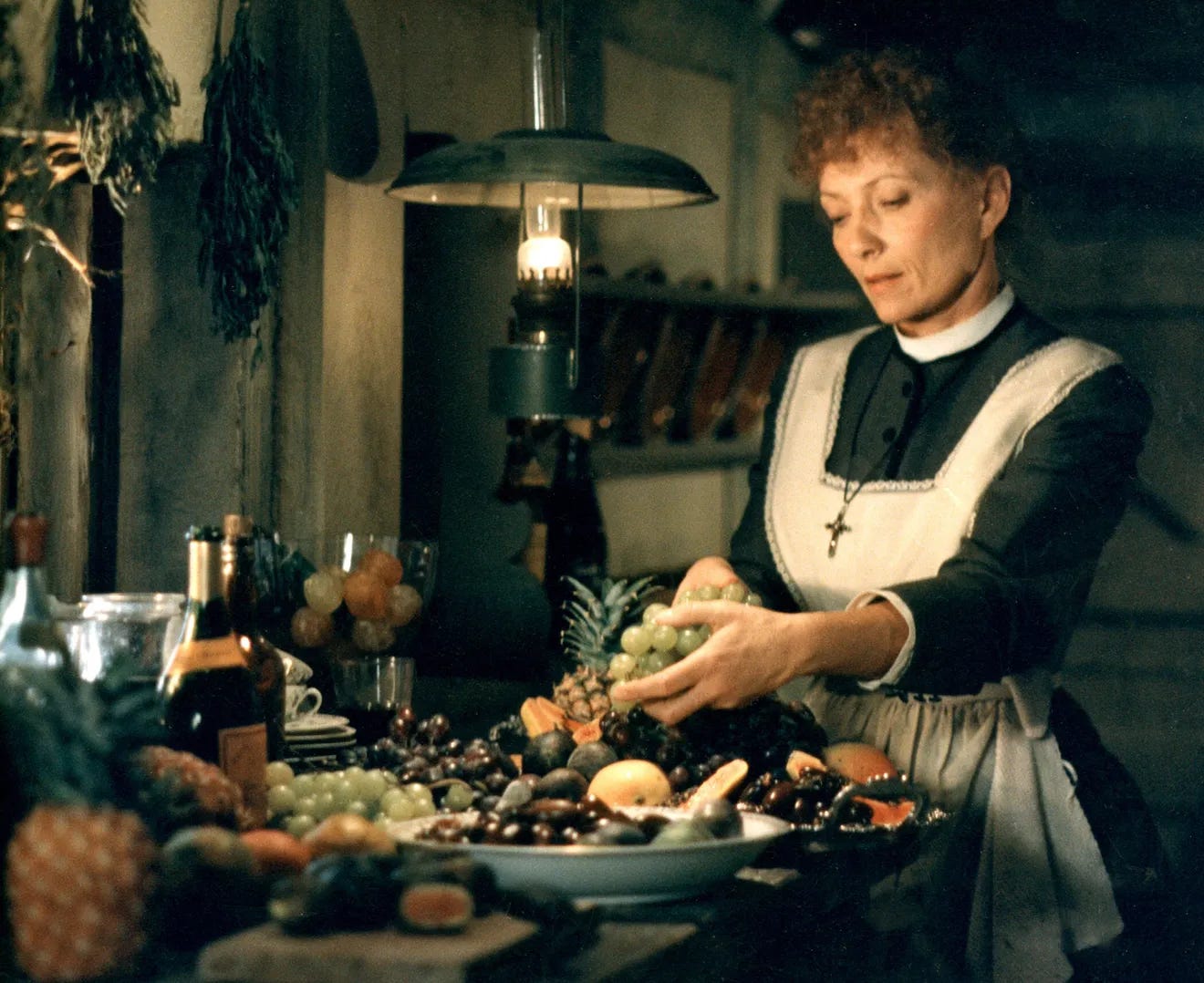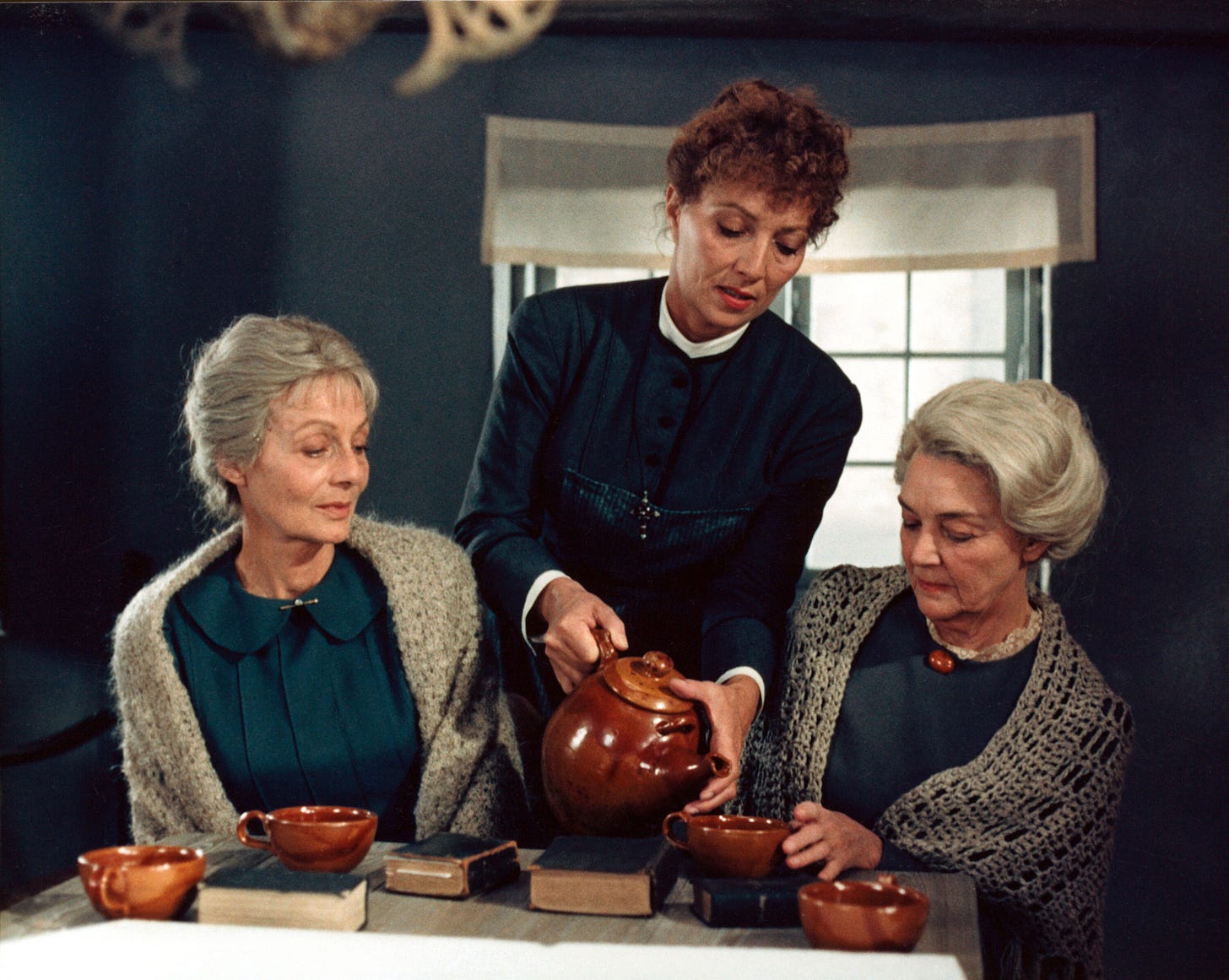The FFFEYIBA Project—1987
“This woman...has the ability to transform a dinner into a kind of love affair, a love affair that makes no distinction between the bodily appetite and the spiritual appetite.”
For a reminder on the purpose (and rules) the project, see this post. Also, as I look ahead to future posts (and see how many Honorable Mentions I’m listing each year), I realize I’m going to have to shorten my HM reflections a bit. You’ll thank me later.
HM #1: Wings of Desire
If the premise doesn’t grab you—”An angel tires of overseeing the human activity of Berlin’s residents, and longs for the tangible joys of physical existence, falling in love with a mortal”—then I’m really not sure what to say. Theologically questionable, perhaps, but wonderfully ethereal, emotionally resonant, and powerful. My first viewing sparked some fascinating thoughts about angels (and about how they’re impacted by time); very thought-provoking, as well as once of the best things my beloved Peter Falk ever did, I’d say. Bonus: This film is the thing that brought Nick Cave to my attention for the first time, for which I will be forever grateful. Bonus For Cinephiles: The closing titles say: “Dedicated to all the former angels, but especially to Yasujiro, François and Andrej,” referring to Ozu, Truffaut, and Tarkovsky, who were particular favorites of Wenders. Oh, and I was “today years old” (as the young people say) when I realized that there’s a sequel to this one, Faraway, So Close! I’m not convinced it needed a sequel, but director Wim Wenders must have thought otherwise. On the other hand, it has Willem Defoe, so…
HM #2: The Princess Bride
Legendarily fun and infinitely quotable, there are few films that so perfectly capture the dual crowns of “cult classic” and “cultural phenomenon” as does Rob Reiner’s fantasty-comedy-swashbuckler. The fact that Wallace Shawn is instantly recognizable to so many Americans warms my heart. Sure, Pixar played a role in that fact, but I still feel that it’s primarily this film’s fault. There are times when it’s a bit too silly for my personal taste, so that probably holds it back from capturing this year’s top spot. But that’s a small criticism in an ocean of enjoyment. (Also, I just realized that the first two HM films for this year both feature Peter Falk. The man’s range was immense.)
HM #3: Empire of the Sun
For years, I’d heard that one of the things preventing Spielberg from being as great as he could be was that he was a sentimentalist; not a “rank sentimentalist,” like Rick, but a man whose desire for happy endings prevented him from being as hard-hitting as certain critics thought he should be. Pulling his punches, so to speak. And then I saw this movie, and never took those people seriously again. The final scene (and the look on young Jim’s face) is just devastating; not sure I’ve recovered, even to this day. HM for the HM: Christian Bale is amazing. Yes, I think he’s always/mostly always amazing in almost everything he does, but his age in this one means that the “degree of difficulty” is particularly impressive. HM for the HM #2: Williams is amazing. “Cadillac of the Skies” is amazing. And “Suo Gân” is especially amazing.
HM #4: The Untouchables
I’ve never been a De Palma fan, but I am happy to make an exception for this one. (And for Mission Impossible. Maybe.) I find most of his films either deeply and intentionally derivative, thematically flighty, or astonishingly ham-fisted (or all three). This one’s certainly derivative at times—Union Station Shootout, anyone?—and it’s hard to describe whatever De Niro’s doing as anything but “ham-fisted.” Yet there’s humanity and heroism in it, as well, which is probably (partially) Mamet’s fault. Still, the performances are excellent (mostly), with a particular nod to Garcia and Costner; Connery is great fun, though I’m less and less convinced it’s a performance and more and more convicted that that’s the way he actually was. Oh, and Morricone’s amazing. “The Strength Of The Righteous” is the perfect, jagged intro; vintage Ennio. And the souring orchestral theme, “The Untouchables,” is one of his finest.
Now, on to 1987.
1987’s Selection: Babette’s Feast, by Gabriel Axel
This one’s a profoundly quiet film; meditative and moving, almost song-like. Just because it’s a quiet film is no reason to mistake it for a little one, though. In fact, it grapples with some of the largest and most important themes there are: faith and friendship, community and ritual, art and how we humans express ourselves and our innermost thoughts, love and loss and sacrifice and triumph. Based on the last work published by Karen Blixen-Finecke (under the pen name Isak Dinesen) while she was alive, it’s a wonderful example of what subtlety in storytelling can do.
It’s Spine #665 over at The Criterion Collection, which describes it thusly:
At once a rousing paean to artistic creation, a delicate evocation of divine grace, and the ultimate film about food, the Oscar-winning Babette’s Feast is a deeply beloved treasure of cinema. Directed by Gabriel Axel and adapted from a story by Isak Dinesen, it is the lovingly layered tale of a French housekeeper with a mysterious past who brings quiet revolution in the form of one exquisite meal to a circle of starkly pious villagers in late nineteenth-century Denmark. Babette’s Feast combines earthiness and reverence in an indescribably moving depiction of sensual pleasure that goes to your head like fine champagne.
The acting is superb—did I mention subtle?—especially the performances of the two sisters and of Stéphane Audran, playing the titular Babette; the cinematography, rich and luminous (despite the town’s desperate desire for asceticism in all things); the storytelling and directing so pitch-perfect that they’re well-nigh impossible to notice. If someone told you it was 1987’s Winner of the Academy Award for Best Foreign Film (making it the first Danish film to carry that distinction), you will be unsurprised, because it is so clearly a masterpiece.
Celebrity chef (and cinephile) Alton Brown considers it “the finest film ever made about cooking and about what it means to be a cook,” and it’s hard to argue with that claim. It’s also hard to think of it as only (or even mostly) about food, because the way in which it speaks about the relationship between the artist and his art (and the artist and his audience) is also so very wonderful. And it’s about as clear a metaphor for Christ as one could find; one of the most explicitly sacramental films I’ve ever seen.
So, it’s about art (and asceticism). And faith (and rigidity). And friendship (and fear). And Christ, surely. And all those things are wonderfully realized and obviously present, and all remind us that great works of art are not myopic or narrow-sighted or singular in their flavor. Instead, great art give us a wonderful smörgåsbord of themes and ideas and emotions to taste and to digest. But let’s not overlook the “real” for the sake of the “metaphorical,” either. Because Blixen-Finecke/Dinesen and Aexl give us all of those things in a story about cooking—about the painstaking, detailed, expensive (in more ways than one) creation and serving/offering up of a meal. So yes, the meal is the highlight of the film, of course.
Or is it? It’s not actually the meal that serves as the most intriguing metaphor in the film, is it? It’s Babette herself. Babette, who arrives unexpectedly, serves and observes the needs of the village and its inhabitants, plans and prepares and pours herself out into the most necessary, most inexplicable, most meaningful meal the people of Jutland will ever experience.
And then, her work done, her sacrifice complete, her grace dispensed, and her meal consumed, she rests.









Babette's Feast is one of my most favorite films. I am adding it to the queue of movies to watch this Lent. Thanks for the reminder, Joseph!